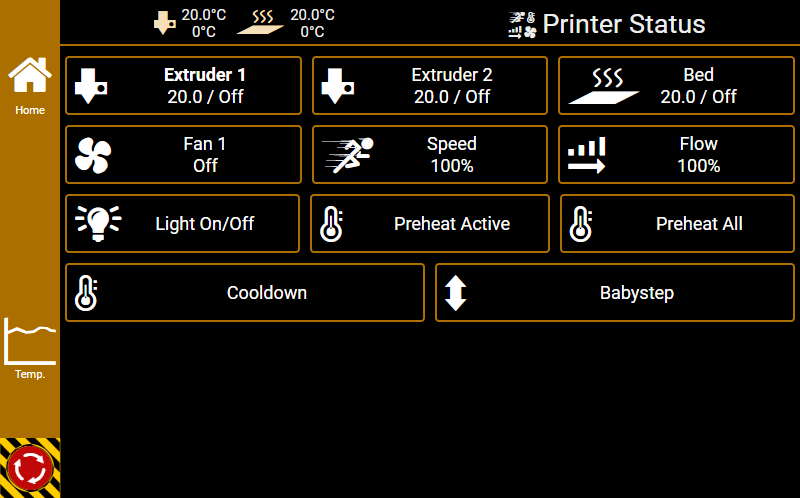

- Repetier server power supply script how to#
- Repetier server power supply script install#
- Repetier server power supply script update#
- Repetier server power supply script mac#
$ sudo cpanm -force -verbose B::CC Boost::Geometry::Utils Math::Clipper Math::ConvexHull Math::Geometry::Voronoi Math::PlanePath Moo Wx $ sudo cpanm -force -verbose ~/ExtUtils-ParseXS-3.18_04.tar.gz $ sudo cpanm -force -verbose ExtUtils::CppGuess ExtUtils::Typemaps ExtUtils::XSpp Now, you can use CPAN to build some dependancies: Now, increase your SWAP pagefile in /etc/dphys-swapfile (make sure your SD card has room): Go to your home directory and clone the Slic3r source:
Repetier server power supply script install#
$ sudo apt-get install cpanminus curl libextutils-cbuilder-perl gcc-4.7 g++-4.7 $ sudo apt-get install git build-essential libgtk2.0-dev libwxgtk2.8-dev libwx-perl libmodule-build-perl libnet-dbus-perl I'm going to try installing Octoprint in a bit, but it needs some Python. RPi-Monitor (data server, lets you know what's up)
Repetier server power supply script update#
To update the software on RPi (the RPi_Monitor will let you know what needs updating): To install a software package (like some of the one's I have listed) with apt-get, you can generally use this command: Because of this, we have access to a tool called apt-get which helps manage the software and programs installed on your pi. Raspbian is a great distro to have with RPi, because it's based on Debian, a really flippin cool branch of Linux. I suggest either using a small self-adhering heatsink for RAM, or cut a larger one up and mount it with thermal glue.Ĥ00px Installing Software Apt-Get Rundown then to escape the instance of screenĪ heatsink should only be necessary for the following reasons: Anything nasty will appear in dmesg.Įcho -n "CPU freq: " cat /sys/devices/system/cpu/cpu0/cpufreq/scaling_cur_freqĮcho -n "CPU temp: " cat /sys/class/thermal/thermal_zone0/tempĬopy and paste the text into a file in your home directory and name it 'stress.sh'. Tests RAM and I/Oįor i in `seq 1 10` do echo reading: $i sudo dd if=/dev/mmcblk0 of=/dev/null bs=4M doneįor i in `seq 1 10` do echo writing: $i dd if=/dev/zero of=deleteme.dat bs=1M count=512 sync done

When logging into the RPi from a terminal, bash can provide a Message Of The Day. Have SSH working? Great, now you need a program that will let you connect! I use and recommend PuTTy Tray for it's utility and aesthetics. I have not used stock Debian on the RPi yet, however there is a guide for setting up SSH: .uk SSH Client
Repetier server power supply script mac#
If, after shutting down or restarting the system you find that the MAC address has reverted, enter the last line again and restart.Įnsure that you have a valid IP address (may need an authenticated MAC as well) and use a program such as PuTTy Tray to connect to the RPi. Restart the RPi and you should now have a new MAC address! Now, navigate to the line above iface eth0 inet dhcp and add auto eth0Īfter iface eth0 inet dhcp add hwaddress ether 00:11:22:33:44:55 Make sure to reformat the MAC address with ':' instead of '-' before installing it on your RPi Next to the field Physical Address is the new MAC address Right click Local Area Connection and select Status
Repetier server power supply script how to#
Here's how to harvest a MAC from an existing on-network computer: If there's an IP there, then the MAC is likely not your problem. Under the eth0 sections, look for an IP next to inet addr

Run the following command to check your interface configuration: Nothing spells futility like simply not setting an IP address to get an IP address. Make sure that your network is using DHCP. In order to validate changing the MAC address, follow these steps: The obvious first sign that you need a new MAC is a lack of internet connectivity. If you unplug the pi to shut it down, the SD has a high chance of becoming corrupt. First Boot Setup Configure eth0 with DHCP


 0 kommentar(er)
0 kommentar(er)
